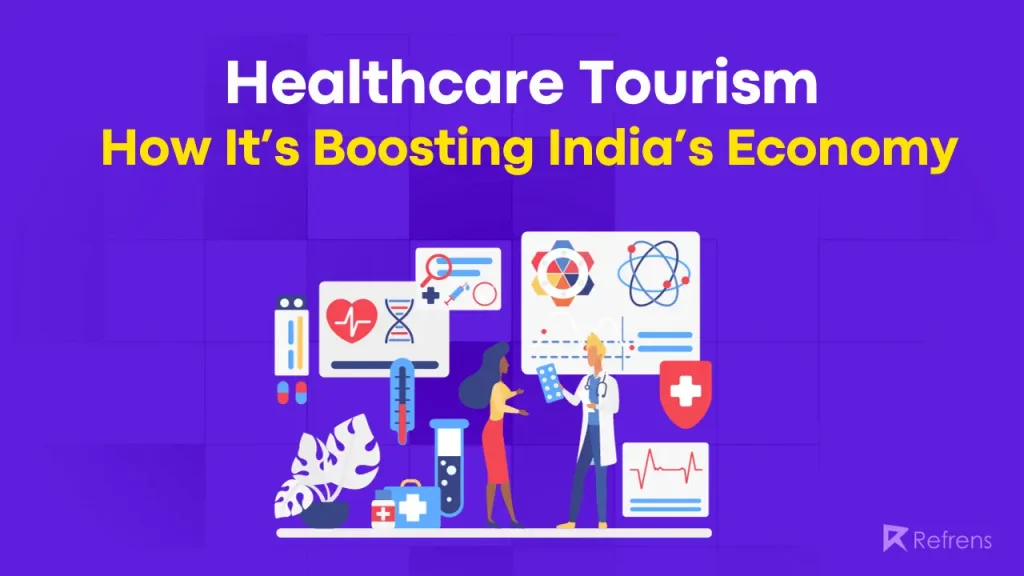Healthcare tourism has been expanding in the last decade, and India belongs to the top destinations patients seek for affordable and high-quality services. India’s healthcare tourists mainly come from neighbouring countries, with a significant majority of total arrivals from Bangladesh (77.6%), Afghanistan (53.6%), Maldives (85.8%), and Iraq (94.7%) travelling to the country for medical purposes. As the number of healthcare tourists also steadily increases by about 22-25% per year, the Ministry of Tourism reported that healthcare tourism generated a revenue of over $3 billion (~₹ 2.49 million lakhs) in 2021 and rebounded in 2022 despite a short decline in 2020-2021.
It is worth noting that despite being an emerging sector, healthcare tourism’s impressive growth and revenue have helped boost India’s economy. As healthcare providers and the national government are tapping into this sector’s economic potential, there are various opportunities for investors and business owners to share the gains of India’s healthcare tourism and further push it toward global markets.
An overview of India’s healthcare tourism
Patients worldwide have varying health needs, which India successfully meets with its wide range of medical treatments delivered by skilled healthcare professionals and providers. Beyond curative and palliative medicine, the same report linked above notes that medical tourists also come to India for specialised and cosmetic surgeries. There has been increasing demand for non-essential medical procedures like hair transplant, liposuction, breast augmentation, rhinoplasty, facelifts, and tummy tucks. Moreover, India offers complementary medicine, such as Ayurveda, yoga, and meditation, to treat chronic disorders like arthritis and rheumatism. These provide alternative treatment to tourists and position India as a unique source of holistic health and wellness source.
Besides the skill and expertise with which these services are delivered, many other factors explain why India is a top destination for healthcare. Hospitals have state-of-the-art facilities and technology and are accredited by the Joint Commission International (JCI) and the National Accreditation Board for Hospitals and Healthcare Providers (NABH) to meet international and local standards for quality patient care and safety. Furthermore, there are lower costs and less waiting time for medical treatment here in India compared to developed nations like the UK, the US, and Australia. Lastly, India’s rich culture, history, and cuisine enable foreigners who arrive for medical purposes to also explore the travel sector.
The effects of healthcare tourism on India’s economy
As India emerges as a hub for healthcare tourism in Asia and worldwide, the growth and benefits extend beyond the sector itself. According to Sunil Talati, Chairman of the Services Export Promotion Council (SEPC), India’s 18% share of the global healthcare tourism market can help catapult the economy. By 2026, the Indian economy could grow by USD 9 billion (~₹ 7.48 million lakhs) with the continued use of traditional medicine, Ayurvedic therapy, yoga, and exercise, combined with the curative aspects of healthcare.
This sector’s economic value and growth potential are not overlooked by the government, either. Just this year, the government launched the new category of AYUSH Visa for foreigners visiting India for traditional medicine like Ayurveda, naturopathy, Unani, Siddha, and homoeopathy. Under the special visa scheme, medical tourists are allowed multiple entries and longer stays depending on medical conditions and treatments. A policy called ‘Heal in India’ was also enacted to drive more foreign travellers and boost healthcare tourism, mainly by actively mandating the accreditation of wellness centres and medical value tourism (MVT) facilitators.
With India’s healthcare tourism supported by government policy and poised for continued growth, there is a great incentive to invest in the sector and share its long-term gains. The following section explores different ways for interested individuals to participate in the burgeoning healthcare tourism industry.
Tips on sharing the gains of the healthcare tourism sector
Invest in healthcare stocks
While the government invests in healthcare tourism through a supportive regulatory environment and increased budget allocation, private investors can contribute to and profit from the sector through healthcare stocks. Notably, the highest-performing healthcare stocks listed in Nifty Healthcare, such as Apollo Hospitals and Abbott India, lifted the index by 1.19% in September 2023, representing increased valuation and share prices for the sector. Investors can also benefit from using a pip calculator when making investment decisions. Online trading platforms – where users can access healthcare stocks – tend to have this type of investment calculator to help determine potential profits and losses if a stock were to move by a percentage in point (pip). These pip movements can stem from healthcare companies reporting their financial statements or the government introducing or updating public health policies.
Choose a niche or specialisation
Beyond stock investments, individuals can directly take part in healthcare tourism either by training to be healthcare professionals or owning an accredited MVT facilitation centre. Whether they take the professional or entrepreneurial route, it helps to choose a niche or specialisation in the industry to better cater to patient needs. As previously discussed in the first section, these niches may be personal wellness, cosmetic or non-essential procedures, complementary or alternative medicine, or clinical care in the form of curative, palliative, or preventative treatment.
Leverage technologies relevant to healthcare tourism
For professionals and facilitators who are already in the industry but want to increase their competitiveness, it helps to leverage technologies that can enhance efficiency and the quality of patient care. Considering video conferencing software serves as a flexible and adaptable communication tool, it can be integrated into telehealth to provide consultations and remotely monitor foreign patients once they finish their treatment and leave the country. It is also critical to adopt cloud computing solutions for storing electronic medical records (EMRs) and making them accessible to patients anywhere in the world. Should medical tourists choose to continue their treatment elsewhere, having these EMRs on the cloud also enables the continuum of care across various healthcare professionals and facilities.
If you work at or own a healthcare tourism centre, Refrens’ tech offerings for issuing invoices, managing accounts, and accepting international payments can also be useful in the administrative side of service delivery. Ultimately, on top of current policy and economic investments in healthcare tourism, digital transformation can help boost the sector’s efficiency, productivity, and competitiveness.


















